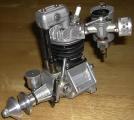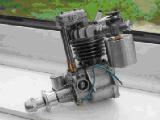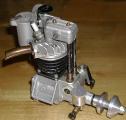| Name | Channel Island Special | Designer | ET Westbury |
| Type | 4-stroke spark | Capacity | 10 cc |
| Production run | "significant" [4] | Country of Origin | England |
| Photo by | Dirk Tollenaar | Year of manufacture | 1949..52(?) |
Peter Chinn, 1955 [4]
Background
The Channel Island Special (CIS), designed by Edgar T Westbury, was the first 4-stroke model engine to enter commercial production in England after World War II (the "Grayson" 4-strokes from E Gray & Son Ltd, circa 1933, would appear to have been the first English 4-stroke production engines [5]). Although it was doomed by the market conditions at the time of its release and production, it is remembered today as an excellent design, made to a very high standard, with corresponding performance (a no load RPM of 21,000 was stated). The name derives from the location of the manufacturer: J&G Jensen Ltd at the La Pouquelaye Works on Jersey, the most southerly of the English "Channel Islands".
 The first appearance of the engine was at the annual Exhibition sponsored by the Model Engineer and held in the Horticultural Hall, London, August 17-27, 1949. Issue 2522 shows the display board prepared by Jensen Ltd for their trade display. It shows all the machined parts in "exploded view", and two versions of the engine, one fitted with a magneto; the other setup for coil ignition [1]. ME did not credit the designer, but the column in which the announcement appeared, I.C. Engines at the "M.E." Exhibition, was probably written by Westbury himself in his capacity as contributing editor, so presumably, archtypical British humility prevailed.
The first appearance of the engine was at the annual Exhibition sponsored by the Model Engineer and held in the Horticultural Hall, London, August 17-27, 1949. Issue 2522 shows the display board prepared by Jensen Ltd for their trade display. It shows all the machined parts in "exploded view", and two versions of the engine, one fitted with a magneto; the other setup for coil ignition [1]. ME did not credit the designer, but the column in which the announcement appeared, I.C. Engines at the "M.E." Exhibition, was probably written by Westbury himself in his capacity as contributing editor, so presumably, archtypical British humility prevailed.
The design shows all Westbury's hallmarks and reflects his passion for engines designed to power tethered hydroplanes. Most of the engines used in competition were air-cooled (or perhaps spray-cooled) since they were only called upon to deliver high power for a short burst. And as they were generally mounted exposed, weight was more important than cooling. As required for an engine intended for "mass production", the CIS was not as sophisticated as some of Westbury's designs published for home construction. However, this was not the reason for its commercial failure. At the time, England was essentially bankrupt and the asking price was comparitively high. The Jensen price list dated April 1, 1950 (perhaps indicating a certain wry sense of homour), was �6-0-0, with a Purchase Tax of �1-11-3 for the standard engine, without coil and plug. Quite a sum in those days. As a historical curiosity, the price list states that the PT component was not to be included with the order, rather paid to the postman on delivery of the parcel! [2] Viewed from today's perspective, this concept seems so bizare and prone to problems as to have originated on another planet.
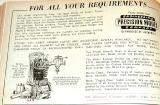 Another factor in the failure of the CIS may have been Jensen's apparent unwillingness to advertise. A diligent scan of the Model Engineer, Model Maker, and (in despiration) Aeromodeller, uncovered only one add for the CIS. This was in the June 1952 issue of Model Maker where the "Enginering Precision Model Company" of Liverpool advertised the CIS stating: "Fameous 10 c.c 4 stroke O.H.V engine [is] Obtainable only from us. As finished Engine �12-0-0 Part-machined �6-10-0 Set Castings �3-5-0". A 100% price-hike in only a year and note that the "fameous" engine is never actually named, suggesting it had already been "remaindered". Engineering Precision themselves did not advertise often, and never repeated the CIS offer.
Another factor in the failure of the CIS may have been Jensen's apparent unwillingness to advertise. A diligent scan of the Model Engineer, Model Maker, and (in despiration) Aeromodeller, uncovered only one add for the CIS. This was in the June 1952 issue of Model Maker where the "Enginering Precision Model Company" of Liverpool advertised the CIS stating: "Fameous 10 c.c 4 stroke O.H.V engine [is] Obtainable only from us. As finished Engine �12-0-0 Part-machined �6-10-0 Set Castings �3-5-0". A 100% price-hike in only a year and note that the "fameous" engine is never actually named, suggesting it had already been "remaindered". Engineering Precision themselves did not advertise often, and never repeated the CIS offer.
Marketing 101 suggests that consumers will not buy something they don't know exists. Even within a comparitively closed, niche market, Word Of Mouth is a risky strategy, especially when the price may be a barrier (although Chinn observes that the motor was astonishingly low priced, considering its exceptionally high quality). So some time in the early 50's, Jensen ceased production. Chinn says that the remaining stocks were purchased by a company in the north of England. He does not name the company, but it was probably not Precision Engineering, who were in Leverpool. Most of these were subsequently sold in the United States through "Octura Products" for around US$28. Certainly, by August 1955, all stocks were exhausted [4], although it appears that Octura continued to supply plans and their own sand castings up to the early 1960's.
Technical Description
 Construction wise, the CIS used a fully ground, 5/16" diameter, overhung crankshaft made from 3% nickel steel. Only the crankpin was case hardened, the shaft itself being left soft allowing owners to thread it, cut a keyway, etc as required by their installation (or fit a collet as frequently advocated by ETW, thus allowing the flywheel to slip in an emergency, like a hydraulic lock induced by a dunking at full speed). Hence, factory supplied engines came with just a bare shaft protruding for 1" from the case front. The shaft ran in a single rear ball-race with a bronze front bushing. The conrod was forged 'duralumin", unbushed. Like most of ETW's designs, the cylinder was one-piece, finned, machined from close grained cast-iron and honed. The flat-topped aluminium piston was fitted with two cast iron rings. The gudgeon pin was fully floating with brass end pads. The crankcase, cylinder head, rocker box and accessories were aluminium alloy die castings.
Construction wise, the CIS used a fully ground, 5/16" diameter, overhung crankshaft made from 3% nickel steel. Only the crankpin was case hardened, the shaft itself being left soft allowing owners to thread it, cut a keyway, etc as required by their installation (or fit a collet as frequently advocated by ETW, thus allowing the flywheel to slip in an emergency, like a hydraulic lock induced by a dunking at full speed). Hence, factory supplied engines came with just a bare shaft protruding for 1" from the case front. The shaft ran in a single rear ball-race with a bronze front bushing. The conrod was forged 'duralumin", unbushed. Like most of ETW's designs, the cylinder was one-piece, finned, machined from close grained cast-iron and honed. The flat-topped aluminium piston was fitted with two cast iron rings. The gudgeon pin was fully floating with brass end pads. The crankcase, cylinder head, rocker box and accessories were aluminium alloy die castings.
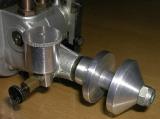 Like many of Westbury's single cylinder 4-strokes, the CIS used positive lubrication rather than a "petroil" blend. An oil resovoir supplied oil via a metering needle valve through a rotary valve in the crankshaft--timed much like a Front Rotary Valve (FRV) two-stroke. On entering the crankcase, this provided an oil mist that lubricated all the moving parts, including the cams and tappets. The crankcase was vented by a non-return valve situated between and behind the tappet guides. The oil tank would sustain an hour of running and it was stated that the arrangement would not leak when the engine was left standing.
Like many of Westbury's single cylinder 4-strokes, the CIS used positive lubrication rather than a "petroil" blend. An oil resovoir supplied oil via a metering needle valve through a rotary valve in the crankshaft--timed much like a Front Rotary Valve (FRV) two-stroke. On entering the crankcase, this provided an oil mist that lubricated all the moving parts, including the cams and tappets. The crankcase was vented by a non-return valve situated between and behind the tappet guides. The oil tank would sustain an hour of running and it was stated that the arrangement would not leak when the engine was left standing.
 Like the Feeney, the cam shaft was driven by a skew gear arrangement allowing it to be positioned at right angles to the crankshaft. A steel gear on the shaft drove a gun metal bronze gear keyed to the cam shaft. The cams, also keyed to this shaft, were fully hardened, and ground from master cams. Flat 'tangential' tappets ran in bronze guides actuating fully enclosed push-rods. The rockers, also fully enclosed, were case hardened steel running on eccentric bronze bushes to provide tappet adjustment. Completing the valve-gear, vertical stainless steel valves ran in bronze guides with the spring-retaining valve caps held in place by circlips locked to the valve stems. The operating instructions state that the rockers should be lubricated every time the engine was run--indicating that despite the enclosed push-rods, it was not expected that oil would be communicated in this way.
Like the Feeney, the cam shaft was driven by a skew gear arrangement allowing it to be positioned at right angles to the crankshaft. A steel gear on the shaft drove a gun metal bronze gear keyed to the cam shaft. The cams, also keyed to this shaft, were fully hardened, and ground from master cams. Flat 'tangential' tappets ran in bronze guides actuating fully enclosed push-rods. The rockers, also fully enclosed, were case hardened steel running on eccentric bronze bushes to provide tappet adjustment. Completing the valve-gear, vertical stainless steel valves ran in bronze guides with the spring-retaining valve caps held in place by circlips locked to the valve stems. The operating instructions state that the rockers should be lubricated every time the engine was run--indicating that despite the enclosed push-rods, it was not expected that oil would be communicated in this way.
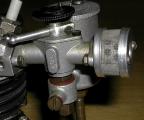 Students of Westbury (as I seem to have become by accident) will be familiar with his fixation on 'correct' carburization, and the intricate designs he evolved to this end. One of his stated justifications was the demands placed on a hydroplane engine carburator due to acceleration. The CIS carby is of the 'compensating' type where rotation of the barrel moves the jet relative to the needle, supplying more fuel as the throttle is opened [3]. The CIS design is remarkably similar in operation to those used by modern R/C pattern competition engines which are subjected to far higher G-loads, and must provide instant throttle response as well. Appearance wise, the CIS carby is Classic Westbury with flanges, bosses, a banjo, gaskets galore, and a charmingly over-engineered actuation arm.
Students of Westbury (as I seem to have become by accident) will be familiar with his fixation on 'correct' carburization, and the intricate designs he evolved to this end. One of his stated justifications was the demands placed on a hydroplane engine carburator due to acceleration. The CIS carby is of the 'compensating' type where rotation of the barrel moves the jet relative to the needle, supplying more fuel as the throttle is opened [3]. The CIS design is remarkably similar in operation to those used by modern R/C pattern competition engines which are subjected to far higher G-loads, and must provide instant throttle response as well. Appearance wise, the CIS carby is Classic Westbury with flanges, bosses, a banjo, gaskets galore, and a charmingly over-engineered actuation arm.
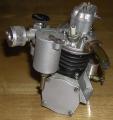 There appears to have been a design change in the carby sometime in the production life of the CIS. The unit fitted to the engine in the Model Engineer photo [1], and described in references [2] and [3] lacks the float chamber seen on the pictured engine. From the evidence, we can assume that early engines were fitted with a simple carby as described. However the engine pictured here, it is clearly augmented with a float-bowel petrol feed, and the quality of the casting and the banjo that connects it to the carby would argue that this is a factory fitment. Aditionally, the carby carries a very neat air-cleaner. The flange to which it is bolted is also evident on the non float-bowel equiped engines in the ME and MM illustrations.
There appears to have been a design change in the carby sometime in the production life of the CIS. The unit fitted to the engine in the Model Engineer photo [1], and described in references [2] and [3] lacks the float chamber seen on the pictured engine. From the evidence, we can assume that early engines were fitted with a simple carby as described. However the engine pictured here, it is clearly augmented with a float-bowel petrol feed, and the quality of the casting and the banjo that connects it to the carby would argue that this is a factory fitment. Aditionally, the carby carries a very neat air-cleaner. The flange to which it is bolted is also evident on the non float-bowel equiped engines in the ME and MM illustrations.
 The contact breaker assembly was actuated by a flat on the camshaft in a way much favoured by Westbury. The moving point spring (insulated in this case) pushed a cylinderical lifter against the cam shaft, holding the points open. A flat on the cam allowed the points to 'make'. The fixed, uninsulated point height could be adjusted for point dwell. The body carrying this asembly rotated to provide spark retardation for starting. The specification [2] notes that the same assembly was used regardless of the spark source--coil or magneto--as would be expected.
The contact breaker assembly was actuated by a flat on the camshaft in a way much favoured by Westbury. The moving point spring (insulated in this case) pushed a cylinderical lifter against the cam shaft, holding the points open. A flat on the cam allowed the points to 'make'. The fixed, uninsulated point height could be adjusted for point dwell. The body carrying this asembly rotated to provide spark retardation for starting. The specification [2] notes that the same assembly was used regardless of the spark source--coil or magneto--as would be expected.
 The CIS has a bore of 15/16" and a stroke of 7/8", giving a displacement of 0.604 cuin (9.9cc). It was set for a compression ratio of 6.5:1 and the stated power output was .52HP at 10,000. The all up weight without flywheel, or coil and associated gear was 18.25 oz. The magneto equiped version weighted 24.75 oz. In 1950, the engine was also available as a set of fully machined parts for �4-17-6 (ex tax), or as a 'raw' castings and materials kit, with plans and instructions for only �2 (I'll take ten). The availability of such kits can provide problems for collectors trying to establish provenance. For example, the parts shown here may, or may not be factory originals. Factory assembled engines appear however to have serial numbers stamped into the carburator, though the meaning in the serial number, if any, is not known. Our subject engine is numbered A128 (the "A" prefix is believed to indicate "Air-cooled"). The highest serial number known to Eric is A198.
The CIS has a bore of 15/16" and a stroke of 7/8", giving a displacement of 0.604 cuin (9.9cc). It was set for a compression ratio of 6.5:1 and the stated power output was .52HP at 10,000. The all up weight without flywheel, or coil and associated gear was 18.25 oz. The magneto equiped version weighted 24.75 oz. In 1950, the engine was also available as a set of fully machined parts for �4-17-6 (ex tax), or as a 'raw' castings and materials kit, with plans and instructions for only �2 (I'll take ten). The availability of such kits can provide problems for collectors trying to establish provenance. For example, the parts shown here may, or may not be factory originals. Factory assembled engines appear however to have serial numbers stamped into the carburator, though the meaning in the serial number, if any, is not known. Our subject engine is numbered A128 (the "A" prefix is believed to indicate "Air-cooled"). The highest serial number known to Eric is A198.
I'm indebted to Dirk Tollenaar for the photos of his new pride and joy, and to fellow Motor Boy, Eric Offen (England) for copies of the original specification, operating, and machining instructions that helped so much with the preparation of his review.
References:
| [1] | annon: I.C. Engines at the "M.E." Exhibition, Model Engineeer, Volume 101, Number 2522, Sep 22, 1949, p382. |
| [2] | Jensen Ltd: 10 c.c."C.I. Special", (copy of engine specification document provided by Mr Eric Offen). |
| [3] | Jensen Ltd: Operating Instructions for the "C.I. Special" 4-stroke engines, (copy of engine operation documentation provided by Mr Eric Offen). |
| [4] | Chinn, PGF: These Engines Were DIFFERENT, Model Airplane News, August 1955. |
| [5] | Nichol, RE: Engines of E. Gray & Son, Ltd, Engine Collectors Journal, Volume 6, Number 3, Spring 1968, p4. |
![]()
